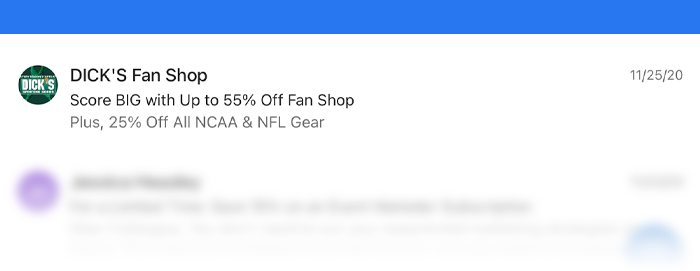11 Subject line mistakes that could hurt your open rates
By Sean Tinney June 13, 2024
Advertising legend David Ogilvy once said, “Five times as many people read the headline as the body copy. When you have written your headline, you have spent eighty cents out of your dollar.”
Like a headline for a blog post or news article, the subject line for your email needs to capture people’s attention and convince them to open your message. A subject line can make or break the performance of your email, so it’s important to spend extra time crafting one that’s memorable and effective.
Good subject lines get to the point, create a sense of urgency, and are relevant to the subscriber, but it’s easy to make mistakes when writing them.
Committing these subject line sins can drastically reduce your open rates, but avoiding them is easy if you know what to look for.
Here are 11 of the most common mistakes people make when writing email subject lines and tips to improve them and improve your open rates.
Why are email subject lines so important?
When you send an email, you only get one chance for the intended recipient to open it. And most of that is tied to a great subject line. A well-crafted subject line grabs attention and sets the tone for the rest of the email. It can make the difference between your email being opened or ignored, influencing engagement and conversion rates.
11 Subject line mistakes to avoid
Understanding the common pitfalls can help you avoid mistakes and create compelling subject lines that drive results. Here are 11 subject line mistakes that could hurt your open rates and how to avoid them.
1. Using ALL CAPS
Imagine receiving an email with a subject line in your inbox: GET 40% OFF YOUR NEXT PURCHASE RIGHT NOW.
You would likely take one of three actions: ignore it, delete it, or mark it as spam. And that doesn’t even account for the annoyance you might have felt receiving such an email.
Before pressing send, keep in mind that USING EXCESSIVE CAPITALIZATION CAN SCARE AWAY SUBSCRIBERS AND KILL YOUR OPEN RATES.
It can appear like you are yelling and hurting your email performance. So, you should use caps in subject lines very carefully.
Do this instead:
Using caps in an email can be effective on a single word in a subject line. But it also needs to be the right word.
Dick’s Sporting Goods does a good job subtly calling out “MORE”, “BIG” and “NOW” in the subject line examples below.



2. Using too much punctuation!!!!
Taking the example we used earlier, imagine we added punctuation—a lot of it: GET 40% OFF YOUR NEXT PURCHASE RIGHT NOW!!!!!!!!!!!!!!!!!!!
You have limited real estate for your subject line, and multiple exclamation marks can come across as spammy. Special characters, such as * % & # and ^, have been known to trigger spam filters, so be sure to use them sparingly.
Do this instead:
Now that we’ve discussed the punctuation mistakes to avoid in your subject line, you may be wondering which characters lead to higher open rates.
The answer? Question marks, exclamation points, and periods. We recommend no more than three punctuation marks per email subject line. When you use too much punctuation, your email looks spammy.
Of course, while this can vary depending on your industry, your audience, and the content of your messages, test multiple subject lines (more on this later) to see which punctuation your subscribers respond to.
Here’s an example of a subject line from Enchanting Marketing:

Using simple language, asking a question, and proper punctuation in her subject line, founder Henneke Duistermaat piques the reader’s interest and entices them to read the message.
Exclamation points, periods, and question marks are all part of a healthy email marketing strategy, so don’t be afraid to mix up the punctuation you use in your subject lines.
3. Using emojis
Okay, we know you might not agree with this one—but we implore you to use emojis sparingly in your subject lines. Yes, emojis can indeed increase open rates. But not always.
The key is to protect your brand image and avoid coming across as cartoony or unprofessional. Emojis work well for some businesses, but they may not be suitable for everyone.
For example, law firms, financial services, and healthcare providers might want to avoid using emojis altogether to maintain a serious and trustworthy image.
Do this instead:
Match the emoji to your business and use them thoughtfully. If you decide to use emojis, ensure they align with your brand and message.
It’s also a good idea to test different subject lines with and without emojis to see what resonates best with your audience. For instance, try “🌟 Special Offer Inside!” versus “Special Offer Inside!” and compare the results to find what works for you.
4. Using Spammy Words
Adding certain trigger words to your subject line can activate a recipient’s spam filter, even if your message is legitimate.
To prevent this from happening, avoid certain words, phrases, and symbols like “$$$,” “100% free,” “cash off,” “cheap,” “weight loss,” and “serious cash.” Even if your email makes it into the inbox, it can come across as spammy to your subscribers.
Do this instead:
To ensure your readers take your emails seriously, carefully choose the language in your subject line by avoiding some of the trigger words and symbols listed above.
Finding the right verbiage for your subject line can be tough, especially with the sophisticated spam filters out today. What works for one industry may not work for another. Be sure to try different variations of words to see what resonates best.
I also recommend focusing on specific words that tie back to the content in your email. Check out this example from our friends at Social Media Examiner:

The subject line tells you exactly what you’ll get by opening up the email. And by focusing on that, it eliminates the risk of including words that might appear spammy.
Bonus Tips: Occasionally adding phrases like “Free” or “Act Now” have been shown to improve open rates, but I recommend using them sparingly to avoid diluting their impact.
5. Making It Too Long
Have you ever read an email communication with run-on sentences after run-on sentences? It’s annoying, right? And it might even turn you off so much that you stop reading altogether. It’s not all that different with subject lines.
People receive many emails daily and don’t have time to read a novel when skimming their inbox. The average person receives 121 emails per day, so yours needs to stand out in a good way. Long, rambling subject lines can get lost in the clutter, causing your message to be overlooked or ignored.
Do this instead:
Aim to get your message across as quickly as possible and cut any unnecessary terms or phrases. Our AWeber team of email experts analyzed the top marketers’ emails and found their email subject lines averaged slightly under 44 characters.
As important as it is to get your message across quickly and clearly, make sure it expresses a complete thought and offers value to the reader – you don’t want to write a subject line that’s too short, either. Avoid one-word subject lines and strive to be helpful and relevant to your subscribers.
Professional photography blogger Courtney Slazinik conveys her message concisely with the following subject line:

By building a message around a numbered list and including the word “secrets,” Courtney offers value and creates a sense of mystery around her content. As a result, this subject line is easily skimmable and irresistibly clickable.
6. Being too generic
Being too generic with your subject lines can be a big mistake. Think about it like this: if you were offering vanilla ice cream, it might not catch anyone’s attention. But if you mentioned a unique flavor like “Salted Caramel Swirl with Chocolate Chips,” people would be more likely to notice and get excited.
Generic subject lines often get overlooked because they don’t stand out in a crowded inbox. They fail to give readers a reason to open your email, resulting in lower open rates and engagement.
Do this instead:
Add some flavor to your subject lines. Make them specific and enticing. For example, instead of “Weekly Newsletter,” try “Discover 5 Secret Tips to Boost Your Productivity This Week.” This captures attention and gives readers a clear idea of what they will gain by opening your email.
7. Writing misleading content
Let’s say you send an email with the following subject: Get an exclusive 50% discount on our entire inventory! But when the reader opens the email, it’s a pitch to sign up for a webinar or free online class.
Not only is this tactic dishonest, but it also tends to backfire. No one likes to be deceived, especially when they receive an email that promises one thing and delivers another.
You might get people to open your email initially, but this alienates subscribers and can hurt your open and spam rates in the long run. If your subscribers lose trust in your emails, they will ignore future emails and mark you as spam.
Align the content of your email and your subject line to build and maintain trust between you and your subscribers. This is especially important considering Google’s EEAT (Experience, Expertise, Authoritativeness, Trustworthiness) philosophy. Even though email is email and Google is Google, misleading subject lines undermine your credibility and can negatively impact your reputation and deliverability.
8. Avoid using RE or FW in Your Subject Lines
Avoid using RE: or FW in your headers. These tend to trick the reader into thinking the email was part of another conversation, which doesn’t leave a positive impression with subscribers. In fact, it can cause confusion, leaving consumers to wonder if the email was sent by mistake.
Not including this text also gives you more room to work within your subject line, which can be used to convey helpful and relevant information instead. Adhering to EEAT principles and being transparent with your subject lines can foster a trustworthy relationship with your audience and improve your email performance.
9. Lacking urgency
Do you want your readers to open your email now? Or, do you want them to wait for weeks, or months, possibly forgetting they received your email altogether? Subject lines that lack urgency often fall flat because they don’t give your readers a reason to act immediately. Without a sense of urgency, your email can get lost in the shuffle of a busy inbox, reducing your open rates and overall engagement.
Do this instead:
Create a sense of urgency in your subject lines to prompt immediate action. Use phrases like “Limited Time Offer,” “Act Now,” or “Only a Few Spots Left.”
For example, instead of “New Product Available,” try “Exclusive Offer: 20% Off New Product – Today Only!” This encourages readers to open your email immediately, improving your chances of growing engagement.
10. Including spelling or grammar errors
Subject lines (or any other content in your email) with typos, misspelled words, and misplaced punctuation look unprofessional and can hurt your open rates.
Emails are an opportunity to establish your brand as a helpful source of information. Subject lines with spelling or syntax errors make a bad first impression, and undermine your ability to establish trust with your subscribers.
Do this instead:
To optimize your email open rates, be sure to review your emails for grammar and spelling prior to hitting send. No one will take the time to read your email if the subject line is loaded with grammar mistakes, but basic copy editing can prevent these errors from slipping through the cracks.
Related: How to test emails before you send them
11. Skipping out on A/B testing
You’ve probably noticed that we have mentioned subject line testing a time or two—or five—throughout this post. And there is a good reason for that—because subject line testing is EASY and COSTS YOU NOTHING. Sorry for the all-caps there, but we want to make sure we hit home on this point.
By skipping out on A/B testing, you miss the opportunity to discover what resonates with your audience. Every email list is different, and what works for one might not work for another. A/B testing allows you to compare different subject lines and determine which one performs better, helping you refine your strategy and improve open rates.
Do this instead:
Make A/B testing a regular part of your email marketing routine. Test variations of your subject lines to see which ones get the most opens and clicks.
For example, you might test “Don’t Miss Our Exclusive Sale!” against “Exclusive Sale – Today Only!” Over time, these insights will help you craft subject lines that are more effective and tailored to your audience’s preferences.
Crafting subject lines that sweep subscribers off their feet
The subject line is one of email’s most important components, so getting it right before you send your emails is a must. And by avoiding the mistakes above, you’ll be well on your way toward improving your email engagement.
Ready to use these tips to write better subject lines? Sign up for AWeber Free today to start writing amazing subject lines.
 87% off ends soon!
87% off ends soon! 
